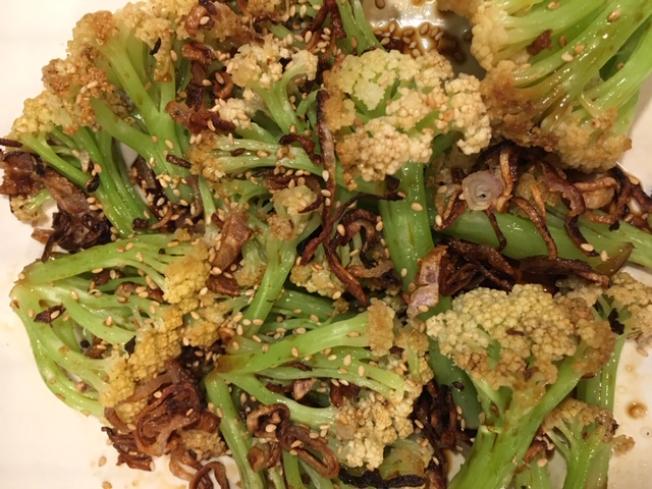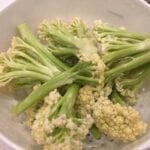Written by Marsha Seidelman, M.D.
January 28, 2020

This recipe was meant to be used with baby bok choy, but TJs and Whole Foods didn’t have any – they did have these cute little baby cauliflowers, though. I haven’t met a vegetable I’m not willing to try cooking – at least once! It turned out great. How bad could agave and tamari sauce be, with a sprinkling of shallots, ginger and toasted sesame seeds?!
When I looked up ‘baby cauliflower’ the photos were of little round vegetables, similar to brussels sprouts. These however, looked like broccolini. According to the Food and Wine website, what I purchased was ‘caulilini’. Evidently, last summer it was released exclusively to chefs in the food industry, but now perhaps it’s at a TJs near you! It’s in the same family as kale, broccoli and cabbage, with similar nutritional value. You can get your vitamin A, C, folate, calcium, potassium, selenium and fiber from it, with very few calories. The taste is milder than large heads of cauliflower.
This recipe calls for mirin, a mildly sweet Japanese rice wine, often used in teriyaki sauce. Compared to sake, it has a lower alcohol content and higher sugar content. If you don’t have mirin on hand, you can use 1 tablespoon of rice vinegar with 1/2 teaspoon of sugar.
How do different cooking oils compare? This recipe calls for peanut oil, which is a good source of vitamin E and has a higher smoke point than olive oil – which didn’t keep it from setting off my smoke alarm when I tossed wet cauliflower into hot oil – oops! There is refined peanut oil, which has an even higher smoke point, but much of the nutritional value is removed and solvents might be added. The main determinant of how stable an oil is for cooking is the polyunsaturated fat content (PUFA). Peanut oil is 34% PUFA, while olive oil is much better at 10%. There is something to be said about the taste of peanut oil for Asian foods, but olive oil would be better healthwise, with a slightly lower saturated fat content.
Finally, while we’re on the subject of ingredients, tamari is similar to soy sauce but usually with less or no wheat (read the label if you’re gluten sensitive), and a bit thicker and less salty than soy.
With this recipe, the baby cauliflower was tender and had a light taste. The sauce did not adhere well to the veggies – which just means fewer calories. But the taste was well enhanced with dipping into the sauce a bit. Overall, we loved the dish and I’ll be making it again – with baby cauliflower or bok choy, depending on what I can find.
Ingredients:
1 pound baby cauliflower
2 small shallots, sliced into very thin rings
1″ fresh ginger, peeled and minced
2 tablespoons peanut oil
1 Tbsp agave nectar or mirin
1 Tbsp tamari
1 Tbsp toasted sesame seeds
Directions:
- Heat the oil over medium heat. Add the sliced shallots and remove with a slotted spatula when lightly browned, otherwise they burn quickly.
- Drizzle extra oil if needed, then add the ginger for 15 seconds, add the cauliflower and stir fry until it softens a little. Add the mirin or agave and tamari, cover and steam on a very low flame.
- Transfer to a serving plate, top with the shallots and sesame seeds.
The same recipe can be used for bok choy or baby bok choy. They would need to be soaked in cold water and swished around several times to remove any sand. Then cut thicker stems into chunks and saute the chunks first for a few minutes before adding the green leafy parts.
Tags: cauliflower, vegan


